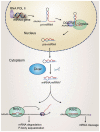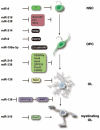Fine-Tuning Oligodendrocyte Development by microRNAs
- PMID: 22347159
- PMCID: PMC3272650
- DOI: 10.3389/fnins.2012.00013
Fine-Tuning Oligodendrocyte Development by microRNAs
Abstract
Myelination of axons by oligodendrocytes in the central nervous system is essential for normal neuronal functions. The failure of remyelination due to injury or pathological insults results in devastating demyelinating diseases. Oligodendrocytes originate in restricted regions of the embryonic ventral neural tube. After migration to populate all areas of the brain and spinal cord, oligodendrocyte precursors undergo a temporally well-defined series of molecular and structural changes, ultimately culminating in the cessation of proliferation, and the elaboration of a highly complex myelin sheath. The emergence of microRNAs (miRNAs) as potent regulators of gene expression at the posttranscriptional level has broad implications in all facets of cell biology. Recent studies have demonstrated a critical role of miRNAs in oligodendrocyte development, including cell proliferation, differentiation, and myelin formation. In this review, we will highlight and discuss the recent understanding of functional links of miRNAs to regulatory networks for central myelination, as well as perspectives on the role of miRNAs in demyelinating diseases.
Keywords: feed-back regulation; miRNAs; myelination; neural cell fate; oligodendrocyte; transcriptional control.
Figures


Similar articles
-
Unwrapping myelination by microRNAs.Neuroscientist. 2012 Feb;18(1):45-55. doi: 10.1177/1073858410392382. Epub 2011 May 2. Neuroscientist. 2012. PMID: 21536841 Free PMC article. Review.
-
MicroRNAs in oligodendrocyte development and remyelination.J Neurochem. 2022 Aug;162(4):310-321. doi: 10.1111/jnc.15618. Epub 2022 May 10. J Neurochem. 2022. PMID: 35536759 Review.
-
Matrix metalloproteinases shape the oligodendrocyte (niche) during development and upon demyelination.Neurosci Lett. 2020 Jun 11;729:134980. doi: 10.1016/j.neulet.2020.134980. Epub 2020 Apr 19. Neurosci Lett. 2020. PMID: 32315713 Review.
-
Sox2 Is Essential for Oligodendroglial Proliferation and Differentiation during Postnatal Brain Myelination and CNS Remyelination.J Neurosci. 2018 Feb 14;38(7):1802-1820. doi: 10.1523/JNEUROSCI.1291-17.2018. Epub 2018 Jan 15. J Neurosci. 2018. PMID: 29335358 Free PMC article.
-
The role of oligodendrocytes and oligodendrocyte progenitors in CNS remyelination.Adv Exp Med Biol. 1999;468:183-97. doi: 10.1007/978-1-4615-4685-6_15. Adv Exp Med Biol. 1999. PMID: 10635029 Review.
Cited by
-
Regulation of the timing of oligodendrocyte differentiation: mechanisms and perspectives.Neurosci Bull. 2013 Apr;29(2):155-64. doi: 10.1007/s12264-013-1314-2. Epub 2013 Feb 28. Neurosci Bull. 2013. PMID: 23456566 Free PMC article. Review.
-
Short-term exposure to particulate matter triggers a selective alteration of plasma extracellular vesicle-packaged miRNAs in a mouse model of multiple sclerosis.Front Immunol. 2025 Jul 3;16:1596935. doi: 10.3389/fimmu.2025.1596935. eCollection 2025. Front Immunol. 2025. PMID: 40677715 Free PMC article.
-
Understanding psoriasis: Role of miRNAs.Biomed Rep. 2018 Nov;9(5):367-374. doi: 10.3892/br.2018.1146. Epub 2018 Sep 11. Biomed Rep. 2018. PMID: 30402223 Free PMC article. Review.
-
Systematic Analysis of mRNA and miRNA Expression of 3D-Cultured Neural Stem Cells (NSCs) in Spaceflight.Front Cell Neurosci. 2018 Jan 11;11:434. doi: 10.3389/fncel.2017.00434. eCollection 2017. Front Cell Neurosci. 2018. PMID: 29375320 Free PMC article.
-
How to make an oligodendrocyte.Development. 2015 Dec 1;142(23):3983-95. doi: 10.1242/dev.126409. Development. 2015. PMID: 26628089 Free PMC article. Review.
References
Grants and funding
LinkOut - more resources
Full Text Sources
Other Literature Sources

